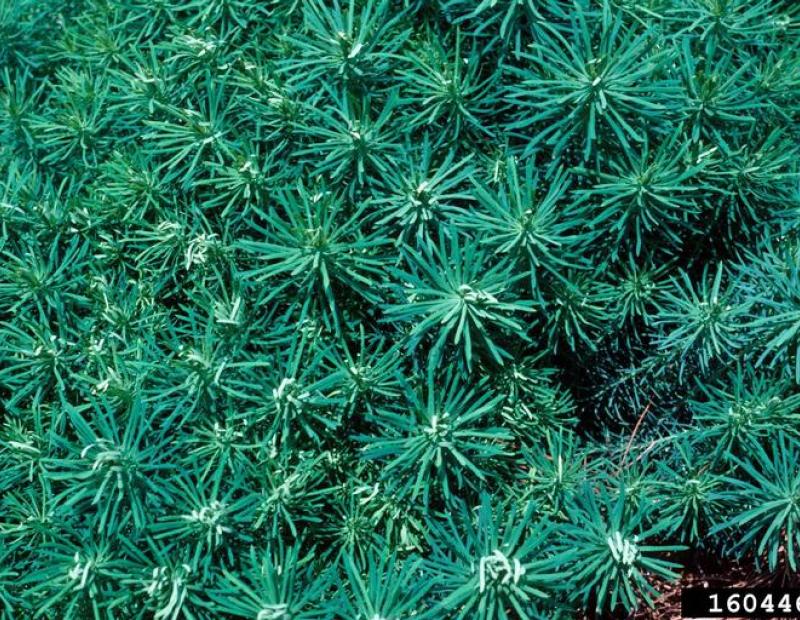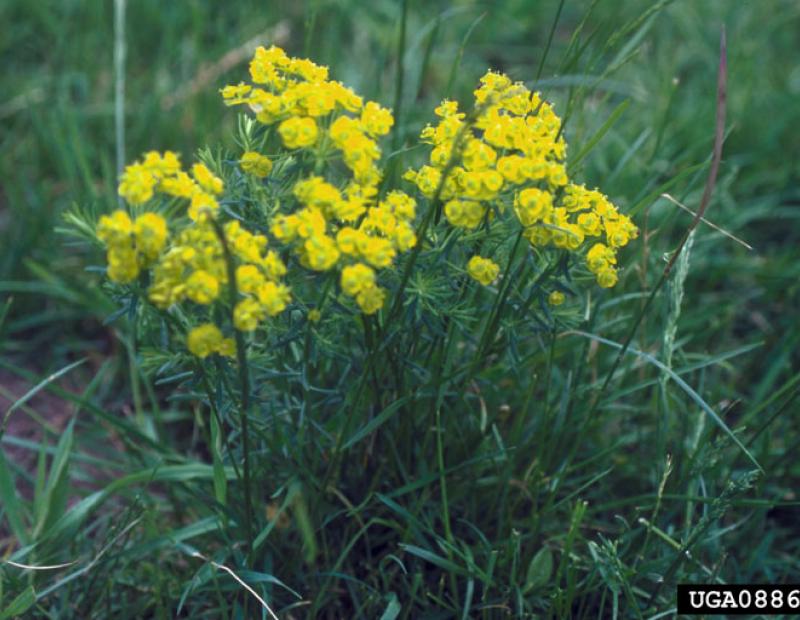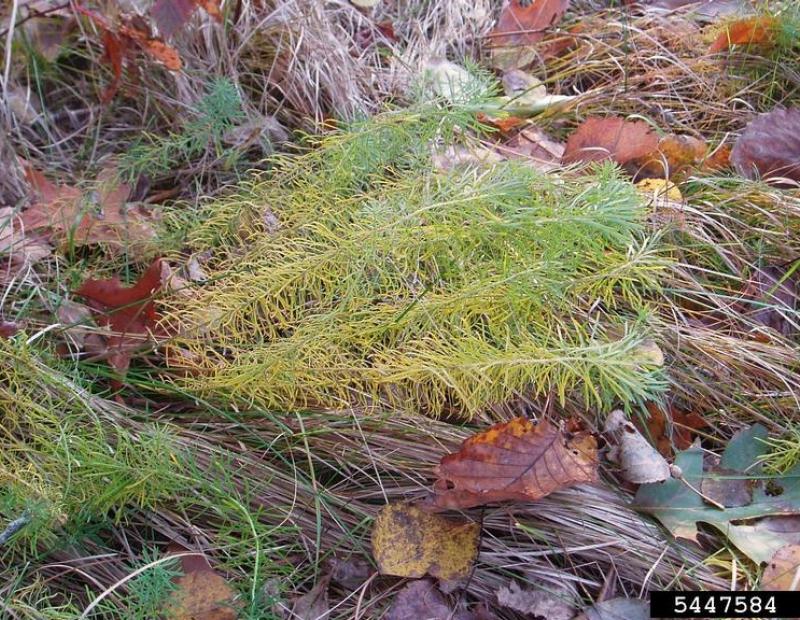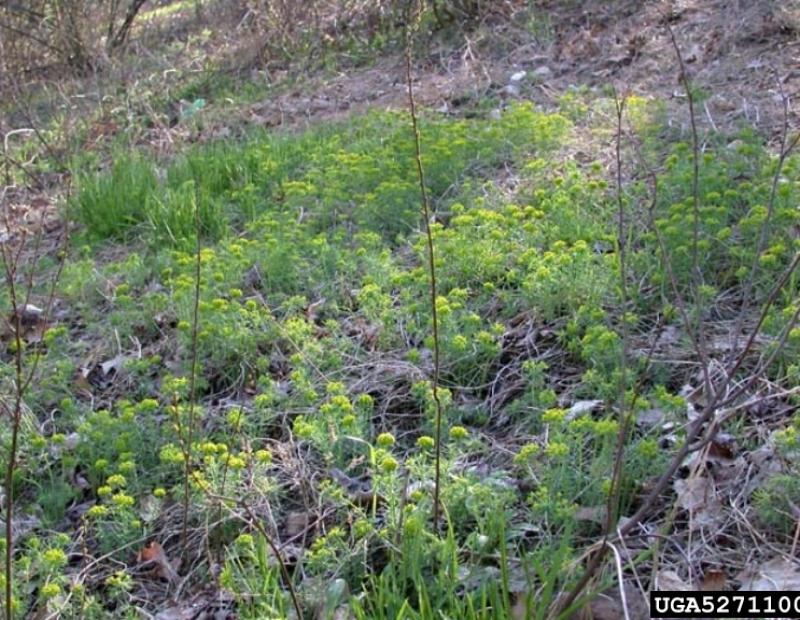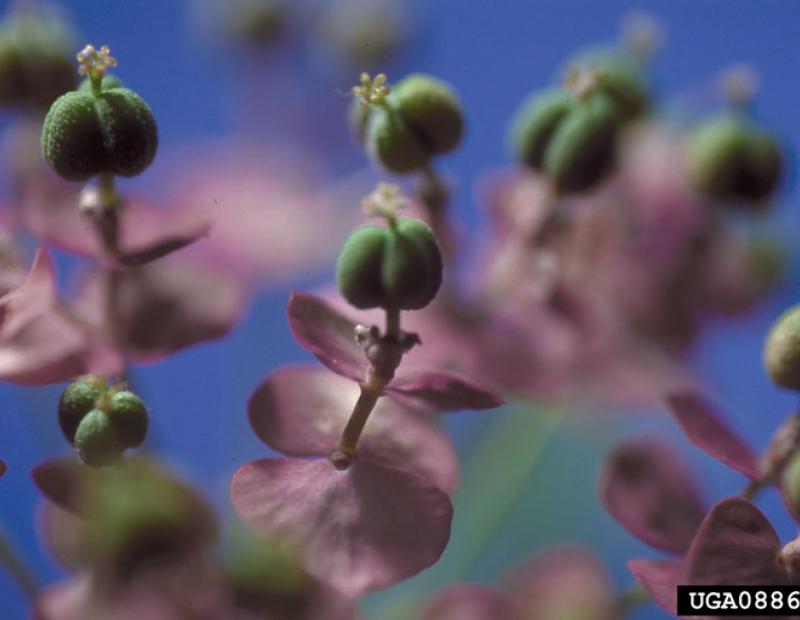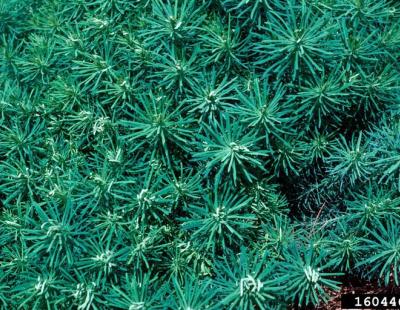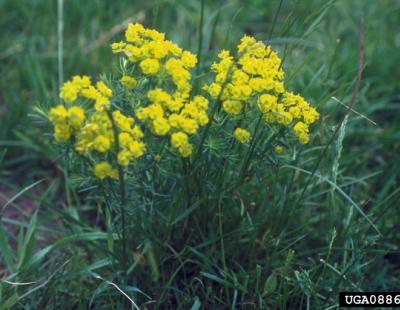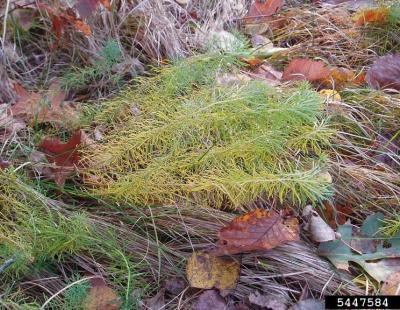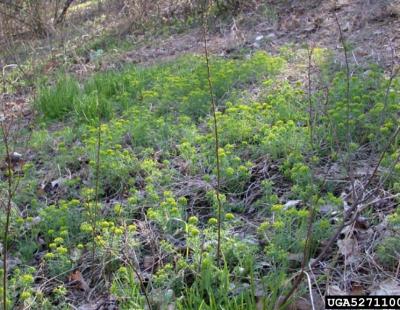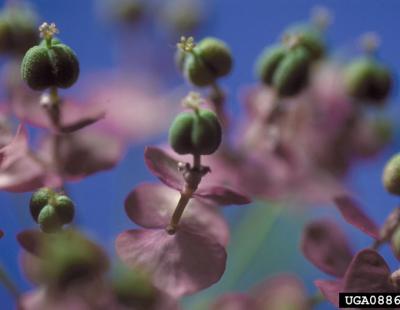Vertical Tabs
- Cypress spurge is a member of the Spurge family (Euphorbiaceae)
- An erect perennial growing to twelve inches Cypress spurge often grows in large clumps due to prolific vegetative growth from an expansive root system. Conspicuous during the growing season due to vivid yellow-green foliage and flowers, all parts of the stem and leaves exude a milky white sap when damaged. (2)
Leaves
Leaves are arranged alternately or whorled, are simple, lance shaped, and approximately one inch long. (2)
Flowers
Flowers are greatly reduced and lack both sepals and petals. The inflorescences are lime green to yellow in color and contain a single female and several male flowers. The flowers turn orange-red to brown as they age. (10)
Leafy spurge is a herbaceous perennial belonging to the Euphorbiaceae family. Capable of rapid vegetative growth this invasive quickly forms monocultures, diminishing diversity and altering composition in the vegetative communities it invades. Furthermore, leafy spurge is toxic, both to other plants and to herbivores. In this way, the species decreases competition from other plants, displaces natives, and destroys rangeland and pasture for agriculture. (4)
Biological Control
Several biological controls are currently being researched and are in active use in North America. Spurge flea beetles and spurge hawkmoth larvae have been successful at providing some measure of control of this noxious invasive, however, several species released have had problems establishing adequate population levels at release sites. (5)
Manual or Mechanical Control
Pulling / Digging Up: Hand pulling or digging young plants is ineffective unless all the expansive and often deeply buried root system is extracted. (5)
Mowing: Cutting or mowing not advisable due to the species’ strong tendency to re-sprout unless it can be consistently performed at least once a month. Mowing stimulates the generation of root buds below ground. (6)
Girdling
Prescribed Fire: Prescribed fire in combination with other management methods, such as the use of biological control agents and two to three applications of herbicide provide some measure of control against Cypress spurge. However, the plant’s deeply buried root system endows this species with a high level of fire resistance. (5)
Prescribed Grazing: Although Cypress spurge is palatable to goats, intensive grazing will not eradicate this species. Compounds in the plant’s sap are toxic to cattle and horses. (5)
Soil Tilling: Not advisable. Soil disturbance will encourage root sprouting, unless deep tilling is done several times per season. (10)
Mulching: No information available
Solarization: Not applicable
Hot Foam Spray: No information available
Chemical Control
The pesticide application rates and usage herein are recommendations based on research and interviews with land managers. When considering the use of pesticides, it is your responsibility to fully understand the laws, regulations and best practices required to apply pesticides in a responsible manner. At times, the pest you seek to treat may not be on a pesticide label, requiring a 2ee exemption from NYSDEC. Always thoroughly read the label of any pesticide and consult the NYSDEC or a licensed pesticide applicator with questions.
Foliar Spray: A foliar spray of aminopyralid or imazapic, applied as flowers are developing, is the most effective method of control against Cypress spurge. Even so, a subsequent application several weeks later will be necessary, along with follow up for at least five years to reach approximately 90% control. (11)
Cut Stump: Not applicable
Basal Bark: Not applicable
Stem Injection: Not applicable
Pre-Emergent Spray: No information available
As with any other invasive infestation complex, large stands of Cypress spurge are best managed via a combination of mechanical, biological and chemical means. Consistent cutting followed by targeted foliar spray, the planting of competitive vegetation and the release of biological control agents will give the most complete, and economical control. Managed infestations should be monitored and controlled for at least five years. All managed sites should be surveilled for at least ten years to watch for newly emerged seedlings. (5)
Post treatment monitoring
Controlled populations should be revisited at least 2-3 times a season for five years. (5)
Disposal Methods
Cypress spurge can be composted unless the plant has already formed viable seed heads, in which case all plant parts must be bagged and disposed of. All parts of the plant’s root can produce new plants and should be thoroughly dried and crushed or discarded in a landfill.
REFERENCES
- https://www.dec.ny.gov/docs/lands_forests_pdf/isprohibitedplants2.pdf
- https://gobotany.newenglandwild.org/species/euphorbia/cyparissias/
- https://plants.usda.gov/core/profile?symbol=EUCY2
- https://mdc.mo.gov/sites/default/files/downloads/leafyspurge.pdf
- https://www.fs.fed.us/database/feis/plants/forb/eupcyp/all.html
- https://www.ag.ndsu.edu/publications/crops/leafy-spurge-control-using-fl...
- https://www.invasive.org/gist/products/handbook/16.imazapic.pdf
- https://www.invasiveplantatlas.org/subject.html?sub=3116
- https://www.fs.usda.gov/Internet/FSE_DOCUMENTS/fseprd499070.pdf
- https://www.maine.gov/dacf/php/gotpests/weeds/factsheets/cypress-spurge-...

